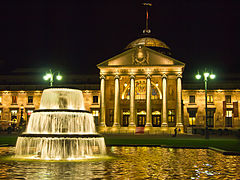Kurhaus Wiesbaden
| Kurhaus Wiesbaden | |
|---|---|

Kurhaus at night (2011)
|
|
| General information | |
| Architectural style | Art Nouveau |
| Location | Wiesbaden, Hesse |
| Address | Kurhausplatz 1 65189 Wiesbaden |
| Country | Germany |
| Coordinates | 50°5′5″N 8°14′51″E / 50.08472°N 8.24750°ECoordinates: 50°5′5″N 8°14′51″E / 50.08472°N 8.24750°E |
| Inaugurated | 1907 |
| Renovated | 1980s |
| Website | |
| www |
|
The Kurhaus ("cure house", pronounced "coor house") is the spa house in Wiesbaden, the capital of Hesse, Germany. It serves as the city's convention centre, and is the social center of the spa town with many events throughout the year. In addition to a large and a smaller hall, it houses a dining restaurant and the Wiesbaden Casino, or Spielbank, which is notable for allowing the "highest roulette stakes in Germany" (as of 2005), and where Fyodor Dostoyevsky was said to have received the inspiration for his novel The Gambler.
The Kurhaus Wiesbaden is in the centre of Wiesbaden, part of the Kureck (spa corner) at the end of the main street, Wilhelmstraße, with the town proper being situated on the other side of the Wilhelmstraße.
Its main entrance, on the west side, faces the so-called Bowling Green, a grass-covered square with two fountains, so named by British spa guests. On the south side of the green is the Hessisches Staatstheater with the Theater colonnade and on the north the Kurhaus colonnade or fountain hall, with a length of 129 metres (423 ft), it is the longest columned hall in Europe. It houses the slot machines for the casino. In 2004–06, an underground parking garage was constructed under the square and the aging plane trees that had formerly stood along both sides were replaced by young trees of the same species. Behind the Kurhaus, the landscaped Kurpark extends eastward, with a band shell and a fountain pond. The park is cited as the most scenic in the city.
Wiesbaden has a long history as a spa town. The Romans already knew of the thermal springs of Wiesbaden. The name of the city is derived from Wisibada, the bathing place in the meadows. In 1810, the first spa house was built by Christian Zais. This was a beautiful but relatively modest building with a columned portico, including Doric and Ionic features, in classical style. Johann Wolfgang von Goethe praised the building on one of his many visits. During the 19th century, the benefits of the spa attracted the upper classes. The number of spa visitors, 20,000 in 1840, had increased tenfold by 1910.
...
Wikipedia
